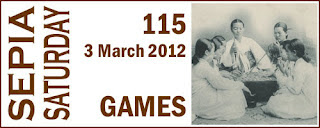One hundred years ago, village bands, town bands, city bands, army bands, navy bands, boys bands, ladies bands, circus bands, theater bands, and even prison bands posed for a camera. But another type of community band shows up less often in photographs - the company band. This postcard shows an rare example of such a factory ensemble, the Famous Wheeler and Wilson Band of Bridgeport, Connecticut. When not playing music, these men made the machines that kept America in stitches, they worked for the Wheeler & Wilson Sewing Machine Company.
| Wheeler & Wilson number 9 machine |
This 26 piece wind band has mostly brass instruments with one flute, 4 clarinets, and 3 drummers. It includes 3 horn players in the back row and a second tuba player on the right who holds a German style instrument which has a more conical bell. Their uniforms are more conservative than the embroidered style of some regimental or town bands of this period.
Many factories, railroad companies, and trade unions maintained bands. Company bands like this played not only for the factory employees but were also part of the local musical culture performing for many civic events. The musicians were usually ordinary employees, but some were professional musicians brought in as soloists. Band leaders especially might be music teachers or noted players engaged to improve the quality of an ensemble. All work and no play was not always a company rule. Last year I wrote about a similar band from another great center of American industry, Milwaukee, Wisconsin, the Kempsmith Band.
In a 1919 edition of The Music Trades. a journal for workers in the music industry offered this report:
The sixtieth anniversary of the Wheeler & Wilson band Bridgeport Conn was celebrated recently George Sanger a member of the band for fifty five years related the history of the band as he recalled it Mr Sanger is the oldest living member of the band.
The cornet player seated second from right has a G.A.R. medal on his coat, a union army veteran's badge of the Grand Army of the Republic. I think he may be George Sanger.
The back is postmarked Bridgeport, Conn August 23, 1910 and addressed to A Usinger Middle-field Ohio.
Dear Brother,
I re-ceived the receipt for the back and round of chairs thanking you for same. do you remember any of the faces on other side of card. best of love to each and every one
Sister Rickie
I re-ceived the receipt for the back and round of chairs thanking you for same. do you remember any of the faces on other side of card. best of love to each and every one
Sister Rickie
Brother Usinger is Andrew Usinger born in Connecticut in 1853. His father was a cabinet maker from Prussia who worked in Bridgeport. In 1870 at age 17, Andrew was the oldest of 5 children and worked in a brass factory. One of his younger sisters was Frederica, undoubtedly the Sister Rickie writing here.
In the 1880 census, Andrew was in Ohio with occupation: Regular Army. The great black hole of genealogy - the 1890 census records that were destroyed by fire, leaves the usual 20 year gap until 1900. Now Andrew is living in Middlefield, Ohio, married with 2 children and working as an Undertaker and Merchant Hardware. At the next census, the year of this postcard, he is still in Middlefield but is a Merchant of Furniture. I bet he got his sister a great deal on those chairs for a wholesale price.
This is my contribution to Sepia Saturday
where you can find more skilled labor by following the link.




































